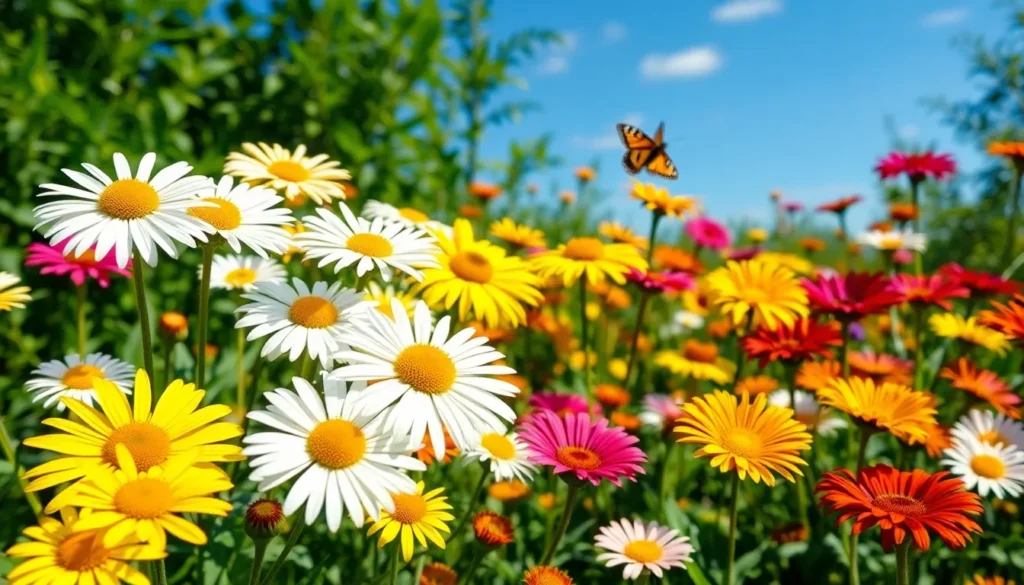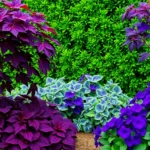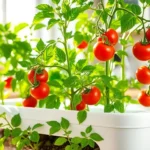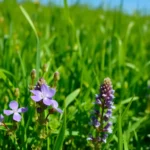We’ve all fallen in love with the classic daisy’s cheerful white petals and sunny yellow center, but did you know dozens of other flowers share this beloved appearance? These daisy-like blooms offer the same simple beauty we adore while bringing unique characteristics that can transform any garden space.
From vibrant asters that bloom well into fall to hardy black-eyed Susans that thrive in challenging conditions, daisy lookalikes provide endless possibilities for creating stunning floral displays. Whether you’re planning a cottage garden or need low-maintenance perennials that deliver maximum impact, these flowers combine familiar charm with exciting variety.
Discovering these daisy alternatives opens up a industry of gardening opportunities – you’ll find options that bloom longer, tolerate different climates, and offer colors beyond the traditional white and yellow palette. Let’s explore the most beautiful flowers that capture that classic daisy magic while bringing their own special qualities to your industry.
Shasta Daisy: The Classic White Beauty
Shasta daisies represent the quintessential daisy appearance that most gardeners envision when thinking of these beloved flowers. We consider them the gold standard for traditional daisy aesthetics in modern landscapes.
Characteristics and Appearance
Petals form the most recognizable feature of Shasta daisies, displaying pristine white coloring that radiates from bright yellow centers. Each bloom typically measures 2 to 4 inches across with 20 to 30 individual petals creating that classic daisy wheel pattern we all know and love.
Foliage emerges as dark green, lance shaped leaves that create an attractive backdrop for the striking white blooms. The leaves grow in dense clumps reaching 12 to 18 inches in height, while flower stems can extend up to 36 inches tall depending on the variety.
Blooming occurs from early summer through fall, providing months of continuous color in garden beds. Double flowering varieties like ‘Becky’ and ‘Alaska’ offer fuller blooms with multiple layers of petals, while single varieties maintain that traditional simple daisy charm.
Growth patterns show these perennials forming substantial clumps over time, making them excellent for naturalizing in meadow gardens or creating mass plantings. Stems remain sturdy and upright, rarely requiring staking even in windy conditions.
Growing Conditions and Care
Sunlight requirements call for full sun exposure, meaning at least 6 to 8 hours of direct sunlight daily for optimal blooming performance. Partial shade locations will produce fewer flowers and may cause stems to become leggy or weak.
Soil preferences lean toward well draining, moderately fertile ground with a pH between 6.0 and 7.0. Heavy clay soils often cause root rot, while sandy loam provides the ideal growing medium for healthy root development.
Watering needs remain moderate, with deep weekly waterings during dry spells proving most effective. We recommend avoiding overhead watering to prevent fungal diseases on foliage, instead directing water to the soil around the base of plants.
Maintenance involves deadheading spent blooms regularly to encourage continued flowering throughout the growing season. Dividing clumps every 3 to 4 years prevents overcrowding and maintains vigorous growth patterns.
Fertilizing should occur once in early spring using a balanced 10-10-10 fertilizer applied according to package directions. Over fertilizing can lead to excessive foliage growth at the expense of flower production.
Black-Eyed Susan: The Golden Daisy Look-Alike
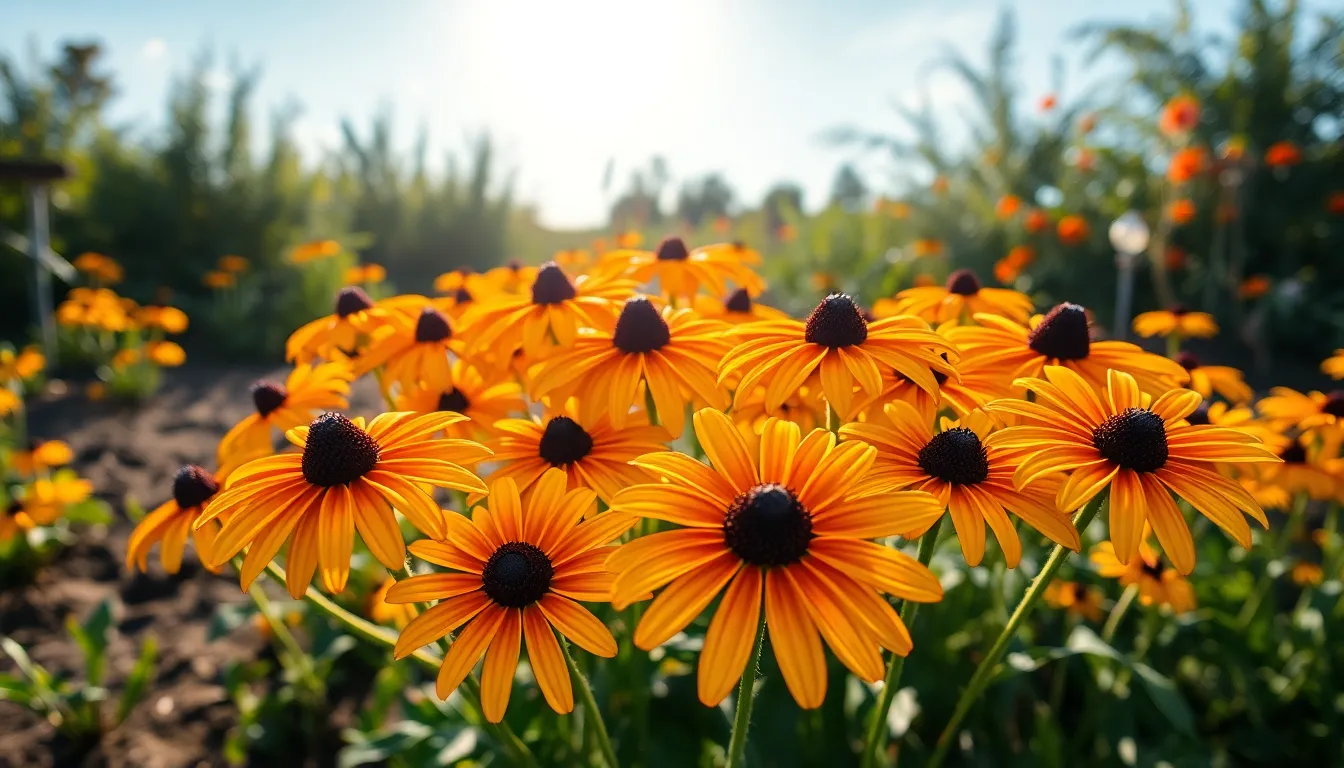
Black-Eyed Susan stands out as one of our most beloved daisy alternatives, bringing warm golden hues to any garden space. We’ve found this resilient flower offers the classic daisy charm with distinctive characteristics that make it truly special.
Distinctive Features and Colors
Bright yellow to orange petals create the signature look that makes Black-Eyed Susan (Rudbeckia hirta) instantly recognizable in our gardens. The prominent dark brown or black central cone rises above the surrounding petals, giving this flower its memorable appearance and common name. We love how the rough-textured leaves and branching stems support multiple blooms per plant, creating abundant displays throughout the growing season.
Growing heights typically reach 1-3 feet tall, making these flowers perfect for mid-border plantings or naturalized areas. The daisy-like structure features ray petals surrounding the raised center, but the bold color combination sets it apart from traditional white daisies. We appreciate how each plant produces many flowers, extending the blooming period and providing continuous color impact.
Best Planting Locations
Full sun exposure gives us the best results when growing Black-Eyed Susan in our gardens. These hardy perennials thrive in well-drained soils and become drought-resistant once established, making them ideal for low-maintenance landscapes. We recommend planting them in wildflower gardens, perennial borders, and naturalized areas where they can spread naturally.
Butterfly gardens benefit tremendously from Black-Eyed Susan plantings, as these flowers attract pollinators throughout their blooming season. Roadside plantings and challenging garden spots work well for these adaptable flowers, which handle heat and moderate drought conditions with ease. We’ve seen excellent results across much of the United States, where these flowers adapt to various climate conditions while maintaining their vibrant appearance.
Gerbera Daisy: The Vibrant Garden Showstopper
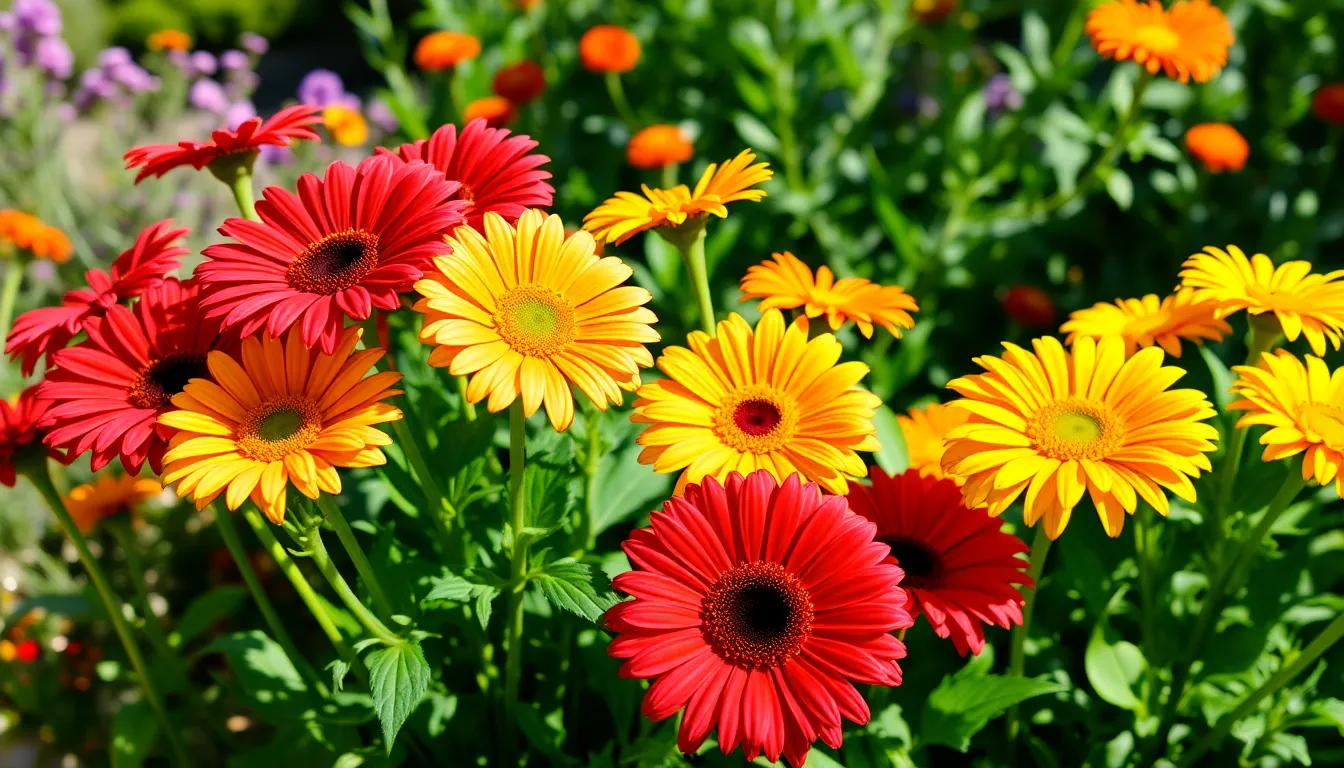
Gerbera daisies bring unmatched elegance to any garden space with their sophisticated structure and polished appearance. We’ll explore why these stunning blooms have become favorites among gardeners seeking daisy alternatives with extra visual impact.
Color Varieties and Sizes
Gerbera daisies showcase an impressive spectrum of vibrant colors that far surpasses traditional white daisies. We can choose from rich reds, soft pinks, bright oranges, and sunny yellows to create stunning focal points in our gardens. These large, daisy-like blooms offer a more structured and polished appearance compared to their wild counterparts.
Size variations allow us to select the perfect gerbera daisy for different garden spaces and design needs. Standard varieties typically produce blooms measuring 3-4 inches across, while compact cultivars work beautifully in containers and border edges. Giant varieties can reach up to 5 inches in diameter, making them exceptional choices for cutting gardens and dramatic industry displays.
Indoor and Outdoor Growing Tips
Light requirements differ between indoor and outdoor gerbera daisy cultivation, giving us flexibility in placement options. We should provide bright, indirect light when growing these flowers indoors, while outdoor plantings thrive in full sun conditions with at least 6 hours of direct sunlight daily.
Temperature control plays a crucial role in successful gerbera daisy care, with optimal growth occurring between 65°F and 75°F. Indoor plants benefit from consistent temperatures away from heating vents and drafty windows. Outdoor varieties can tolerate slightly warmer conditions but may struggle in extreme heat above 85°F.
Watering practices require careful attention to maintain healthy root systems without encouraging fungal problems. We need to keep soil consistently moist but never waterlogged, checking the top inch of soil before adding water. Container plants typically need more frequent watering than garden planted specimens.
Soil preparation ensures proper drainage while providing necessary nutrients for vigorous bloom production. Well-draining potting mix works best for container growing, while outdoor beds benefit from amended garden soil with compost or organic matter. Adding perlite or coarse sand improves drainage in heavy clay soils.
Fertilization during the growing season supports continuous flowering and strong plant development. We should apply balanced fertilizer every 2-3 weeks during active growth periods, reducing frequency in fall and winter months when plants enter dormancy.
Chamomile: The Delicate Herb with Daisy Charm
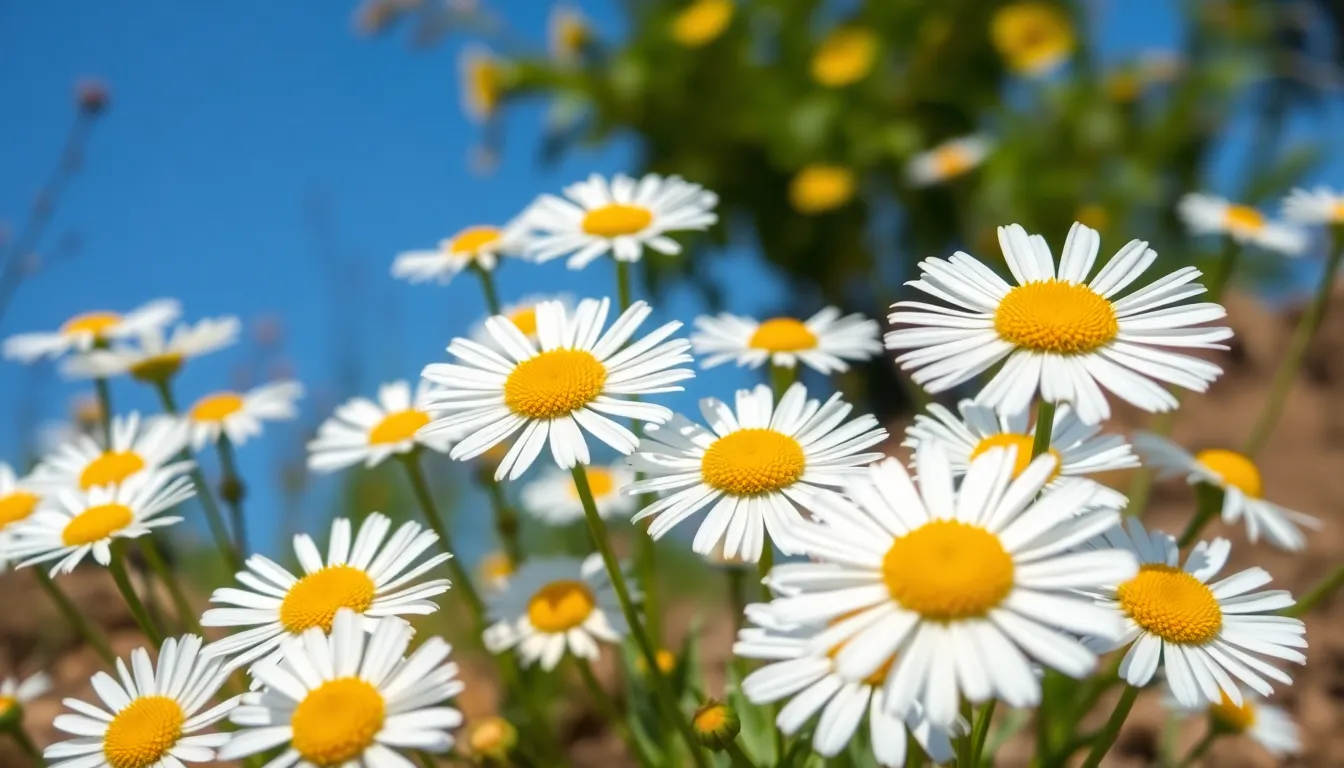
Chamomile stands out among daisy lookalikes for its dual purpose as both an ornamental flower and a valuable medicinal herb. This delicate beauty combines the classic white petaled appearance we love in daisies with practical benefits that make it a worthwhile addition to any garden.
Medicinal Properties and Uses
Calming effects make chamomile one of the most popular herbal remedies worldwide. We often recommend chamomile tea to those seeking natural sleep aids, as it helps reduce stress and promotes relaxation before bedtime.
Anti-inflammatory properties allow chamomile to soothe various skin conditions when applied topically. Many gardeners appreciate having fresh chamomile flowers available for creating homemade skincare treatments and gentle face washes.
Digestive support represents another key benefit of this versatile herb. Chamomile tea can help settle upset stomachs and reduce mild digestive discomfort after meals.
Anxiety reduction occurs naturally when we consume chamomile regularly. The herb contains compounds that interact with brain receptors to promote a sense of calm without causing drowsiness during daytime use.
Cultivation Requirements
Well-drained soil provides the foundation for successful chamomile growing. We’ve found that chamomile thrives in sandy or loamy soils that don’t retain excess moisture around the roots.
Full sun exposure ensures optimal flower production and essential oil development. Chamomile plants need at least 6-8 hours of direct sunlight daily to maintain their compact growth habit and abundant blooming.
Easy maintenance makes chamomile perfect for beginning herb gardeners. The plants self-seed readily and require minimal care once established, making them ideal for naturalized garden areas.
Regular harvesting actually encourages more flower production throughout the growing season. We recommend picking chamomile flowers in the morning after the dew has dried for the highest concentration of beneficial compounds.
Aster: The Fall-Blooming Daisy Cousin
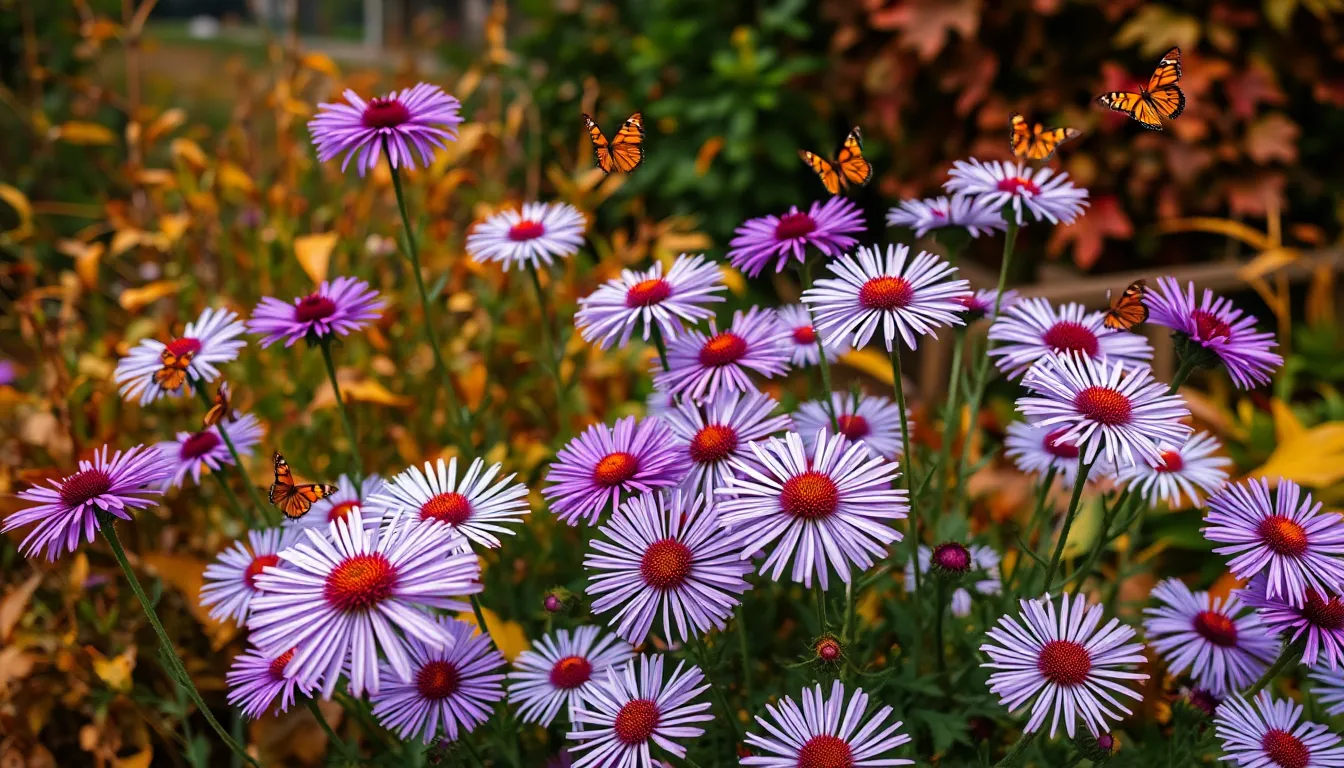
Asters bring autumn magic to our gardens when most other daisy-like flowers start to fade. We treasure these hardy perennials for extending our blooming season well into the cooler months.
Seasonal Blooming Patterns
Fall blooms make asters stand out among daisy alternatives since they peak when other flowers wind down. Timing varies by species, but most asters begin flowering in late summer and continue through October. We appreciate how these reliable bloomers fill the gap between summer’s end and winter’s arrival.
Extended flowering periods give us months of continuous color rather than brief seasonal displays. Native asters adapt to local climate patterns, ensuring consistent performance year after year. Weather conditions influence bloom duration, with cooler temperatures helping flowers last longer.
Late season pollinators depend on asters for critical nectar sources when few other options remain available. Butterflies and beneficial insects flock to these flowers during their autumn migrations. We’ve observed monarch butterflies particularly drawn to purple and white aster varieties.
Varieties and Color Options
Purple asters dominate the species with shades ranging from deep violet to soft lavender tones. New England asters showcase vibrant purple blooms that create stunning mass displays. We recommend these for naturalized areas where their spreading habit works best.
White flowering varieties offer crisp, clean alternatives to traditional purple selections. Aromatic asters produce small white flowers in dense clusters that brighten shaded garden areas. These compact varieties work well in formal borders where controlled growth matters.
Pink and blue selections expand our color palette beyond the standard purple options. Smooth asters feature pale blue to pink flowers on sturdy stems reaching 3-4 feet tall. We find these intermediate colors blend beautifully with autumn foliage and late season ornamental grasses.
Size variations range from dwarf 6-inch varieties to towering 6-foot specimens for different garden applications. Compact selections like ‘Purple Dome’ stay under 18 inches while providing dense flower coverage. Taller varieties create excellent background plantings or privacy screens when mass planted.
Ox-Eye Daisy: The Wild Meadow Favorite
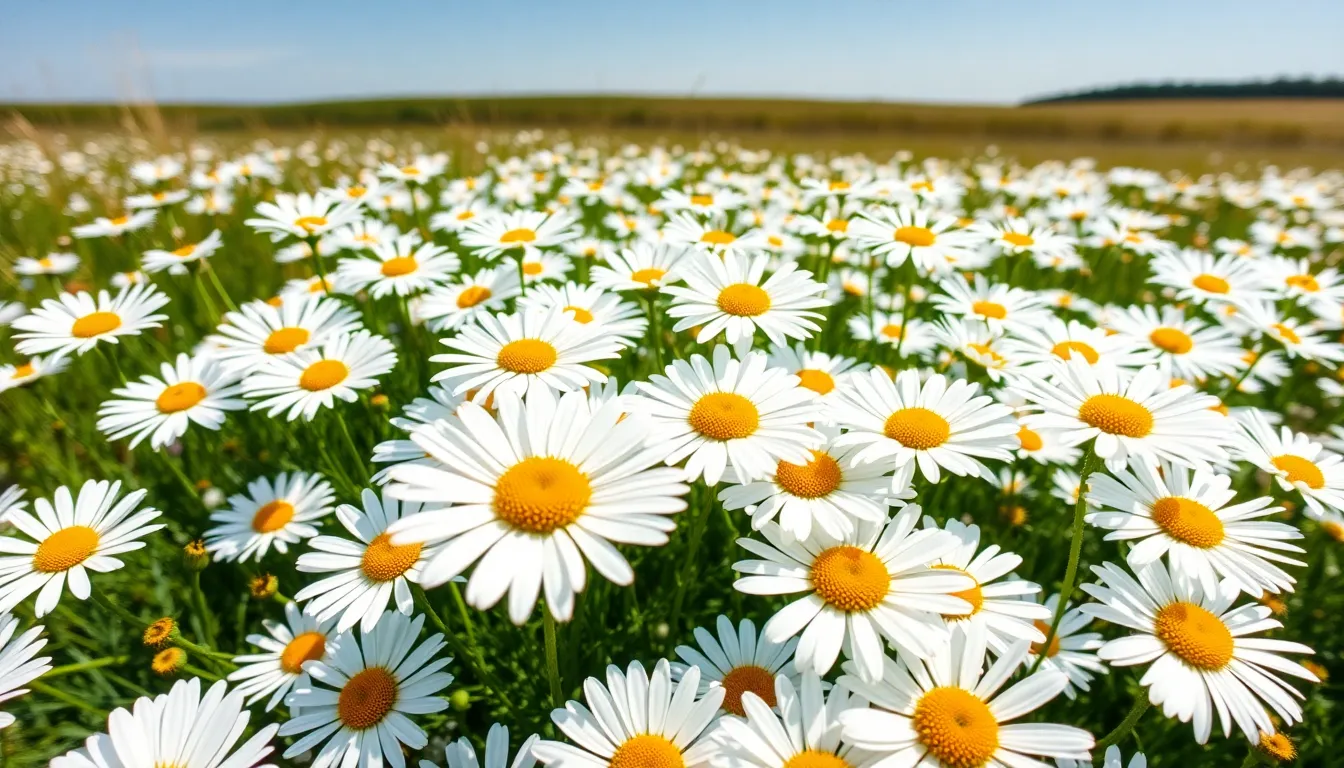
We encounter ox-eye daisies as one of nature’s most charming wildflowers that perfectly mimics the classic daisy appearance. These resilient blooms bring authentic meadow beauty to any garden setting.
Natural Habitat and Spread
Ox-eye daisies thrive naturally in open meadows and grasslands across North America. Fields and roadsides provide ideal growing conditions where these hardy perennials establish robust colonies. Seeds disperse easily through wind and wildlife, allowing rapid colonization of suitable areas.
Dense patches form quickly once ox-eye daisies take root in favorable locations. Open spaces with minimal competition from other plants become prime real estate for these spreading beauties. Disturbed soils along pathways and field edges often showcase the most impressive displays of naturalized ox-eye daisy communities.
Wildlife plays a crucial role in seed distribution, carrying the small seeds on fur and feathers to new territories. Agricultural areas often witness spontaneous ox-eye daisy populations appearing after soil cultivation creates perfect germination conditions.
Identification Features
White petals surround a bright yellow center, creating the quintessential daisy appearance we recognize instantly. Each flower head measures approximately 1-2 inches across with 20-30 narrow white petals radiating from the central disc.
Tall stems reach heights of up to 3 feet in optimal growing conditions, supporting the cheerful blooms well above surrounding vegetation. Branching occurs naturally along the main stem, creating multiple flower heads per plant during peak blooming season.
| Feature | Description |
|---|---|
| Petal Color | Pure white |
| Center Color | Bright yellow |
| Flower Size | 1-2 inches across |
| Plant Height | Up to 3 feet |
| Petal Count | 20-30 per flower |
Leaves display an alternate arrangement along the stem with simple, lance-shaped profiles that distinguish ox-eye daisies from similar species. Serrated edges appear along the leaf margins, while the base leaves form a rosette pattern during early growth stages. Stem leaves become progressively smaller toward the top of the plant, creating an attractive graduated appearance.
Growth habits include both single-stem specimens and multi-branched plants depending on growing conditions and available space. Robust root systems develop extensive networks that support the plant’s spreading tendencies and drought tolerance capabilities.
Painted Daisy: The Colorful Perennial Alternative
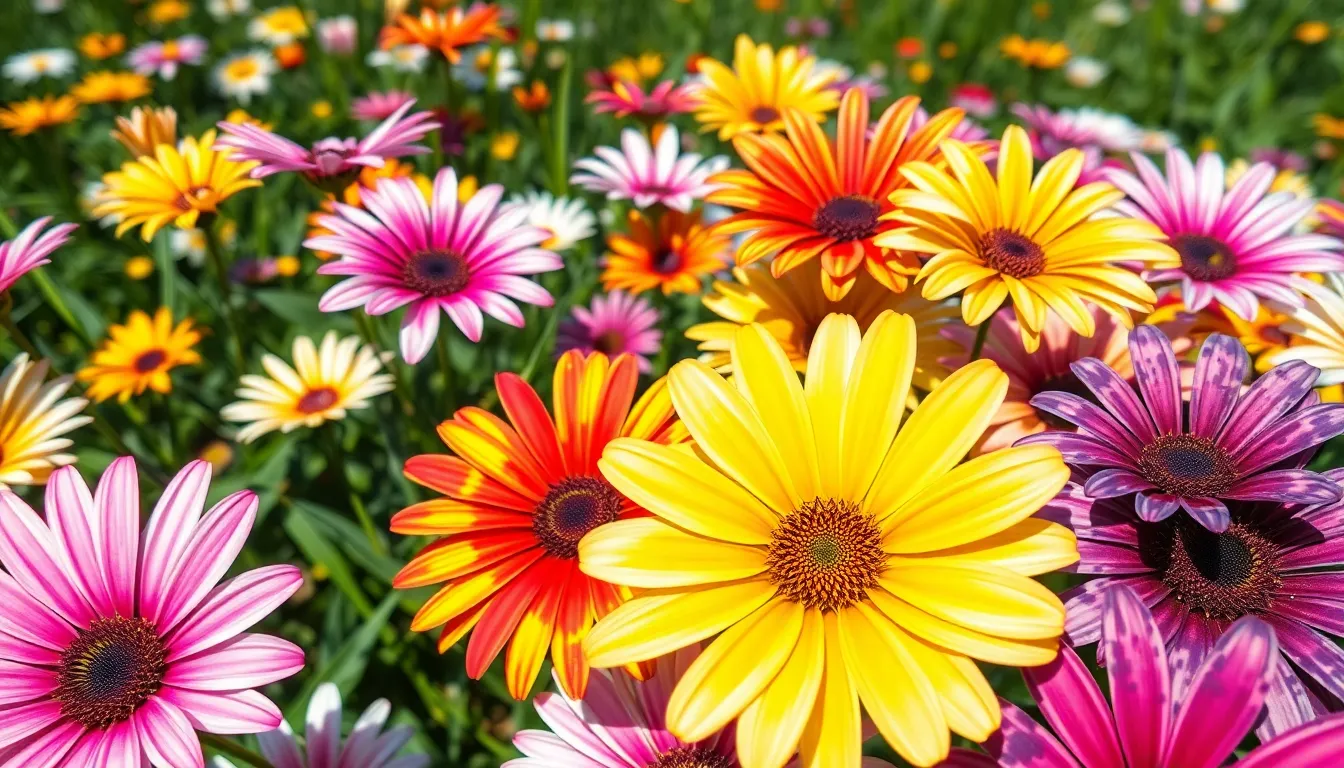
Painted daisies stand out among daisy alternatives with their vibrant, often striped or mottled petals that create stunning visual displays. These perennials offer gardeners a reliable option that combines beauty with durability.
Unique Petal Patterns and Hues
Painted daisies showcase remarkable diversity in their petal coloration and patterns that set them apart from traditional white daisies. We often find these flowers displaying colorful stripes, mottled designs, and gradient effects that create eye catching arrangements. Artists and gardeners appreciate how the petals can feature multiple colors within a single bloom, ranging from soft pastels to bold, contrasting combinations.
Each flower head presents unique variations in its petal patterns, making every bloom slightly different from its neighbors. Gardens benefit from this natural diversity as painted daisies create ever-changing focal points throughout the growing season. Color combinations frequently include pink and white stripes, yellow and red gradients, or purple and lavender mottled effects that catch sunlight beautifully.
Maintenance and Longevity
Painted daisies require moderate care while delivering exceptional value as perennial garden additions that return year after year. We recommend establishing these plants in well draining soil with adequate sunlight to ensure healthy growth patterns. Regular watering during establishment helps build strong root systems, though mature plants show decent drought tolerance.
Deadheading spent blooms encourages continuous flowering throughout the growing season and maintains tidy garden appearances. Dividing clumps every three to four years prevents overcrowding and promotes vigorous new growth. Winter preparation involves cutting back stems to ground level after the first hard frost, allowing energy to concentrate in the root system for spring emergence.
These hardy perennials typically live 5-7 years with proper care, making them cost effective choices for sustainable garden designs. Fertilizing in early spring with balanced fertilizer supports robust bloom production throughout the extended flowering period that often lasts from late spring through early fall.
Fleabane: The Delicate Wildflower Mimic
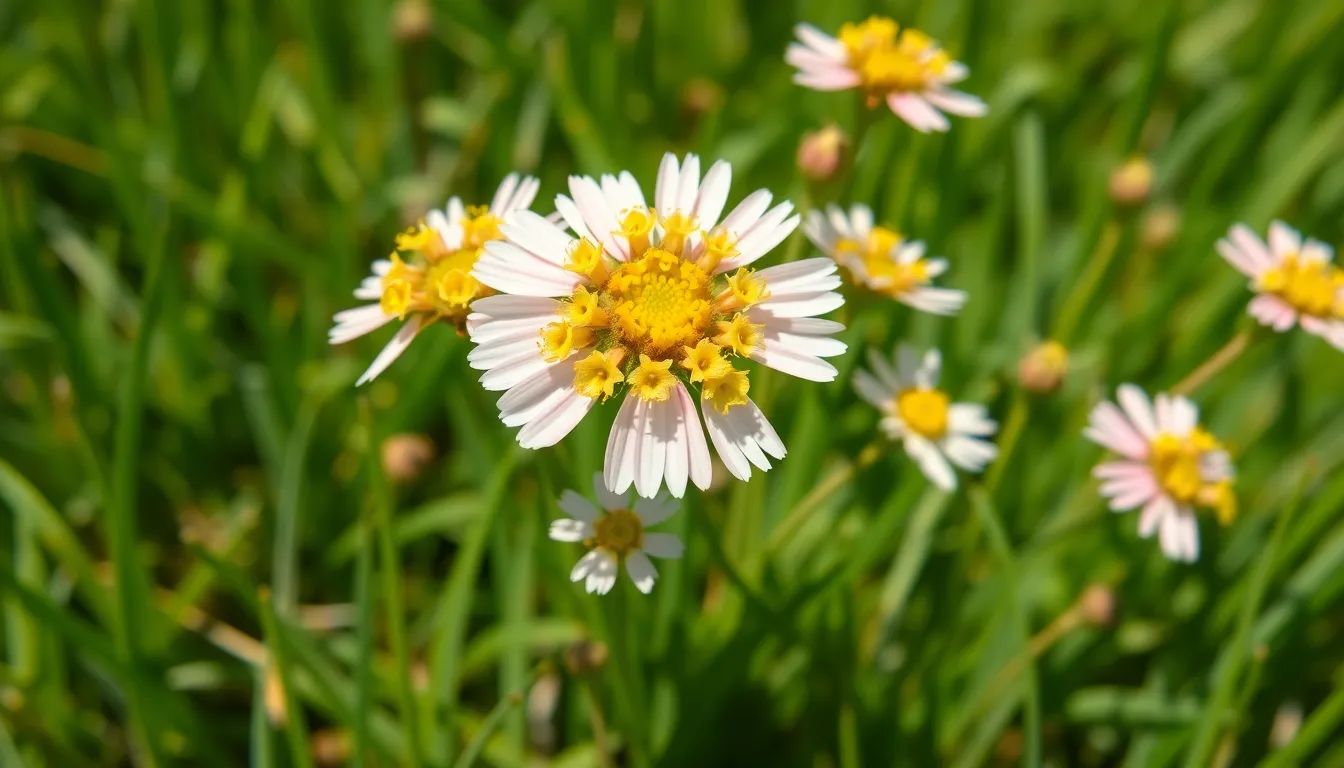
Fleabane stands out as one of nature’s most convincing daisy mimics, offering gardeners a charming wildflower that captures the essence of classic daisies while providing its own unique appeal. We often encounter these delicate beauties in natural settings where they create stunning displays that rival traditional garden varieties.
Distinguishing Characteristics
Delicate white or pink flowers with bright yellow centers make fleabane instantly recognizable to those familiar with its miniature daisy appearance. We notice that fleabane flowers typically measure smaller than traditional daisies, creating an almost fairy-like quality in garden spaces and wild meadows.
Many thin petals radiate from each flower head, giving fleabane a more delicate and refined appearance compared to the broader petals of true daisies. We appreciate how these slender petals create a softer, more ethereal look that works beautifully in cottage gardens and naturalized areas.
Multiple flower heads cluster together on branching stems, creating impressive displays that can span several weeks during peak blooming season. We find that this clustering habit makes fleabane particularly effective as a mass planting or border accent.
Fine, narrow leaves grow alternately along the stems, distinguishing fleabane from many daisy varieties that feature broader foliage. We observe that these leaves often have slightly toothed edges, adding textural interest even when the plant isn’t in bloom.
Native Growing Regions
North America serves as the primary native habitat for most fleabane species, where we find them thriving in diverse ecosystems from coast to coast. Canada and the United States host many fleabane varieties that have adapted to different climate zones and soil conditions.
European meadows and grasslands also support native fleabane populations, particularly in regions with temperate climates and well-drained soils. We’ve documented successful fleabane colonies throughout the British Isles, Scandinavia, and continental Europe.
Parts of Asia provide additional native growing regions for certain fleabane species, extending the plant’s natural range across multiple continents. We observe that Asian varieties often display subtle differences in flower size and petal arrangement compared to their North American counterparts.
Open fields and meadows represent the preferred natural habitat where fleabane establishes robust colonies and self-seeds readily. We recommend mimicking these conditions in garden settings by providing full sun exposure and avoiding overly rich soils that might encourage excessive foliage growth at the expense of flowering.
Marguerite Daisy: The Mediterranean Beauty
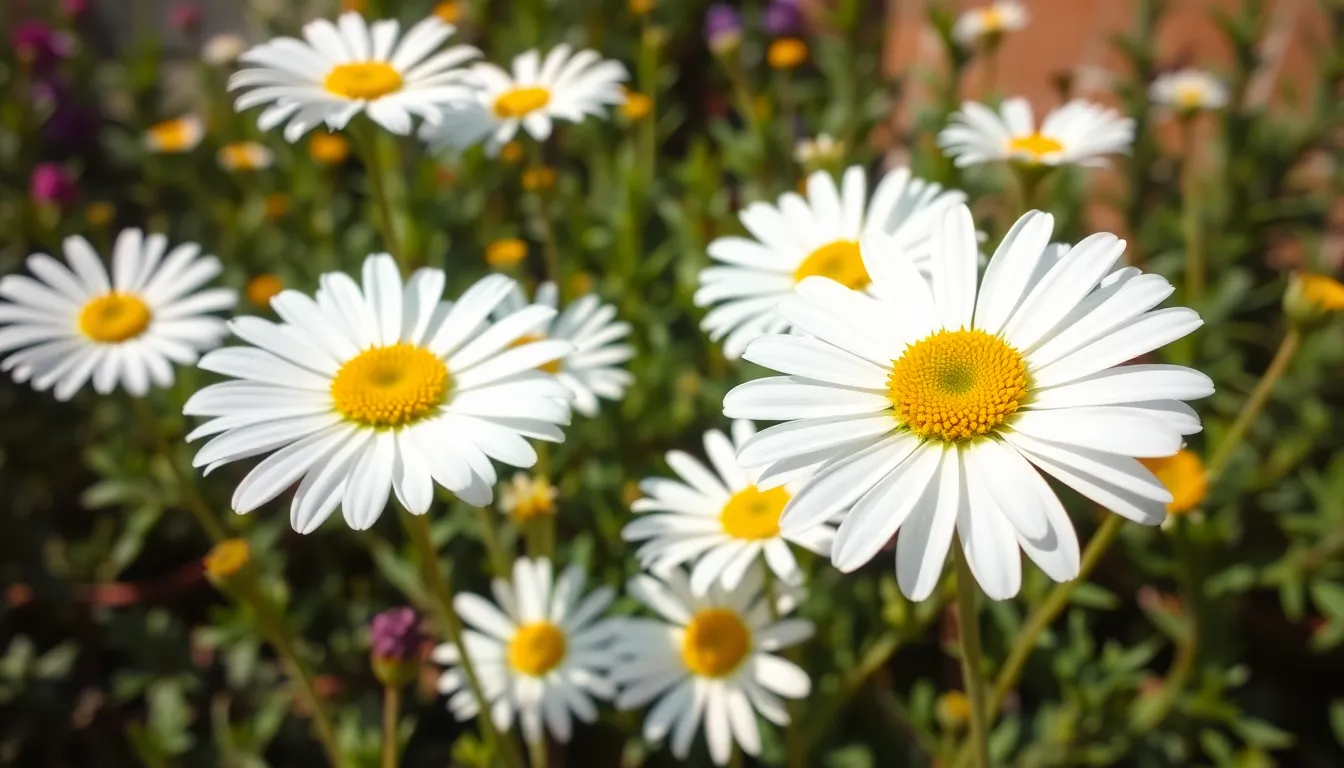
Marguerite daisies bring Mediterranean elegance to gardens with their delicate white petals and cheerful yellow centers. We’ve found these adaptable perennials offer continuous blooms throughout the growing season when properly maintained.
Climate Preferences and Adaptability
Mediterranean climates provide the ideal growing conditions for marguerite daisies, where warm, dry summers and mild winters create perfect environments. We recommend well-drained soil as the foundation for successful cultivation since these flowers originate from regions with excellent drainage. Cooler regions can still support marguerite daisies with proper winter protection and strategic placement in sheltered locations.
Adaptability makes marguerite daisies suitable for various climate zones beyond their native Mediterranean range. We’ve observed successful growth in USDA zones 9-11, with some varieties tolerating zone 8 conditions. Protection from harsh winds and excessive moisture ensures better survival rates in borderline climates.
Full sun exposure produces the most abundant flowering, though partial shade works in extremely hot climates. We suggest providing afternoon shade in areas where summer temperatures consistently exceed 90°F to prevent stress and flower fading.
Pruning and Seasonal Care
Regular deadheading enhances blooming performance by redirecting energy into new flower production rather than seed development. We recommend removing spent blooms every few days during peak growing season to maintain continuous flowering from spring through fall.
Pruning back marguerite daisies after their main flowering period promotes new growth and prevents the plants from becoming leggy. We typically cut stems back by one-third to one-half their height in mid to late summer. This practice encourages fresh foliage and often triggers a second flush of blooms.
Seasonal maintenance includes monitoring soil moisture levels to prevent both drought stress and root rot conditions. We water deeply but infrequently, allowing soil to dry slightly between watering sessions. Winter care in marginal climates involves mulching around the base and protecting from freezing temperatures that can damage tender growth.
Tips for Growing Daisy-Like Flowers Successfully
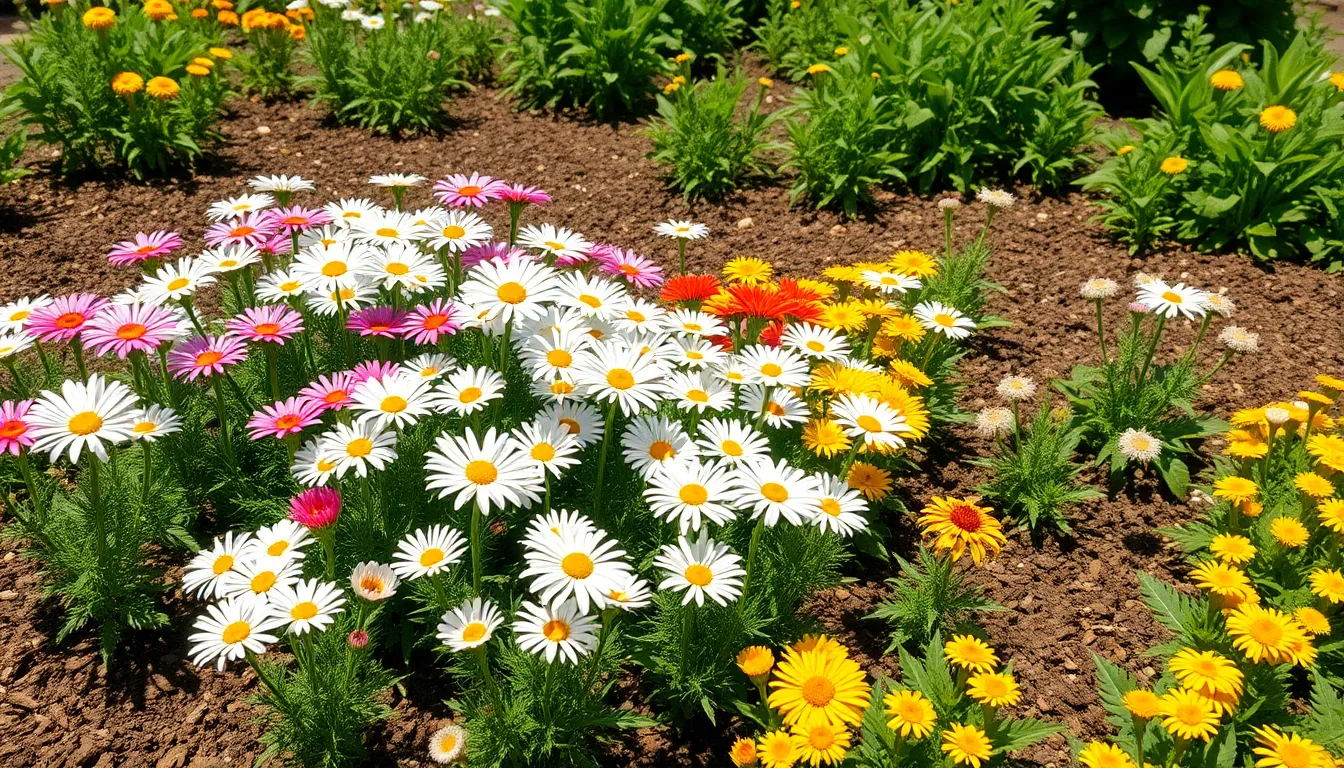
Creating beautiful displays with daisy-like flowers requires understanding their exact needs and preferences. We’ll share essential cultivation techniques to help you achieve stunning results in your garden.
Soil Requirements and Preparation
Well-draining soil serves as the foundation for most daisy-like flowers to thrive successfully. We recommend testing your soil drainage by digging a small hole and filling it with water – if water remains after 24 hours, you’ll need to improve drainage. Heavy clay soils benefit from organic matter additions like compost or sand to enhance water movement and prevent root rot.
Most daisy-like varieties prefer neutral to slightly acidic soil conditions for optimal growth. English daisies specifically need consistently moist yet well-draining soil to maintain their vibrant appearance throughout the growing season. African daisies and desert star daisies can tolerate drier conditions once established but still require proper drainage during their initial establishment period.
Soil preparation becomes crucial before planting your chosen varieties. We suggest incorporating 2-3 inches of compost into the planting area to improve soil structure and provide essential nutrients. Raised beds work exceptionally well for daisy-like flowers in areas with poor drainage or heavy soil conditions.
Watering and Fertilization Guidelines
Established daisy-like flowers like African daisies and desert star daisies demonstrate remarkable drought tolerance once their root systems develop. We recommend deep, infrequent watering sessions rather than frequent shallow watering to encourage strong root development. English daisies require more consistent moisture levels to maintain their lush foliage and continuous blooming cycles.
Balanced, slow-release fertilizers work best when applied at planting time and again in early spring for perennial varieties. We’ve found that over-fertilizing actually reduces bloom production and weakens plant structure, so moderation proves key. Monthly applications of diluted liquid fertilizer during the growing season support consistent flowering without overwhelming the plants.
Mulching provides multiple benefits for daisy-like flowers by retaining soil moisture and controlling weed competition. We apply a thin 2-3 inch layer of organic mulch around plants, keeping it away from the base to prevent stem rot. Moisture-loving varieties like English daisies particularly benefit from consistent mulch coverage to maintain their preferred soil conditions throughout the growing season.
Conclusion
We’ve explored an incredible variety of daisy-like flowers that can transform your garden into a vibrant display throughout the seasons. From the classic elegance of Shasta daisies to the warm autumn colors of asters each option brings its own unique charm and growing requirements.
The beauty of these alternatives lies in their versatility and adaptability. Whether you’re looking for drought-tolerant options like Black-Eyed Susans or seeking the medicinal benefits of chamomile these flowers offer practical answers for every gardening goal.
Success with daisy-like flowers comes down to matching the right variety to your exact conditions and maintenance preferences. With proper soil preparation watering techniques and seasonal care you’ll enjoy continuous blooms that attract pollinators and create stunning focal points in your industry.
Start with one or two varieties that appeal to you most and gradually expand your collection as you gain confidence in growing these rewarding flowers.
Frequently Asked Questions
What are the best daisy alternatives for extending the blooming season?
Asters are excellent daisy alternatives for extending the blooming season, flowering from late summer through October when most other daisy-like flowers fade. Black-Eyed Susans also provide long-lasting blooms and are extremely hardy. These alternatives offer diverse colors and longer flowering periods compared to traditional daisies.
How do I care for Shasta Daisies in my garden?
Shasta Daisies need full sun and well-draining soil with moderate watering. Deadhead spent blooms regularly to encourage continuous flowering. Divide clumps every few years to maintain healthy growth, and fertilize in early spring with balanced fertilizer to enhance flower production.
Are Black-Eyed Susans difficult to grow?
No, Black-Eyed Susans are very easy to grow and low-maintenance. They prefer full sun and well-drained soil, and are drought-resistant once established. These hardy perennials grow 1-3 feet tall and are perfect for butterfly gardens, thriving in various climate conditions across the United States.
Can I grow Gerbera Daisies indoors?
Yes, Gerbera Daisies can be grown both indoors and outdoors. For indoor cultivation, provide adequate light, maintain proper temperature, and follow careful watering practices. They require well-prepared soil and regular fertilization during the growing season to ensure healthy growth and continuous blooming.
What are the benefits of growing chamomile?
Chamomile combines ornamental beauty with medicinal benefits, offering calming effects for sleep and relaxation, anti-inflammatory properties for skin conditions, and digestive aid. It’s easy to maintain, self-seeds naturally, and thrives with minimal care in well-drained soil and full sun exposure.
When do asters typically bloom?
Asters bloom from late summer through October, making them valuable fall-blooming flowers. They provide critical nectar sources for late-season pollinators like monarch butterflies and come in various colors including violet, lavender, white, pink, and blue, with sizes ranging from 6 inches to 6 feet tall.
What soil conditions do daisy-like flowers prefer?
Most daisy-like flowers prefer well-draining soil with good drainage being essential. For heavy clay soils, add organic matter to improve drainage. Use balanced, slow-release fertilizers in moderation, and apply mulch to retain soil moisture and suppress weeds for optimal plant health.
How often should I water daisy-like flowers?
Water established daisy-like flowers deeply but infrequently to encourage deep root growth. Some varieties like English daisies need consistent moisture, while others like Black-Eyed Susans are drought-tolerant. Always check specific variety requirements and avoid overwatering to prevent root problems.
Are Painted Daisies long-lasting perennials?
Painted Daisies are cost-effective perennials with a 5-7 year lifespan and long blooming periods from late spring through early fall. They require moderate care, thriving in well-draining soil and adequate sunlight. Regular deadheading and dividing clumps every few years promotes vigorous growth.
What makes Marguerite Daisies special?
Marguerite Daisies offer Mediterranean elegance with delicate white petals and cheerful yellow centers. These adaptable perennials thrive in warm, dry climates but can grow in cooler regions with proper care. They require full sun exposure and regular deadheading for continuous blooms throughout the growing season.

